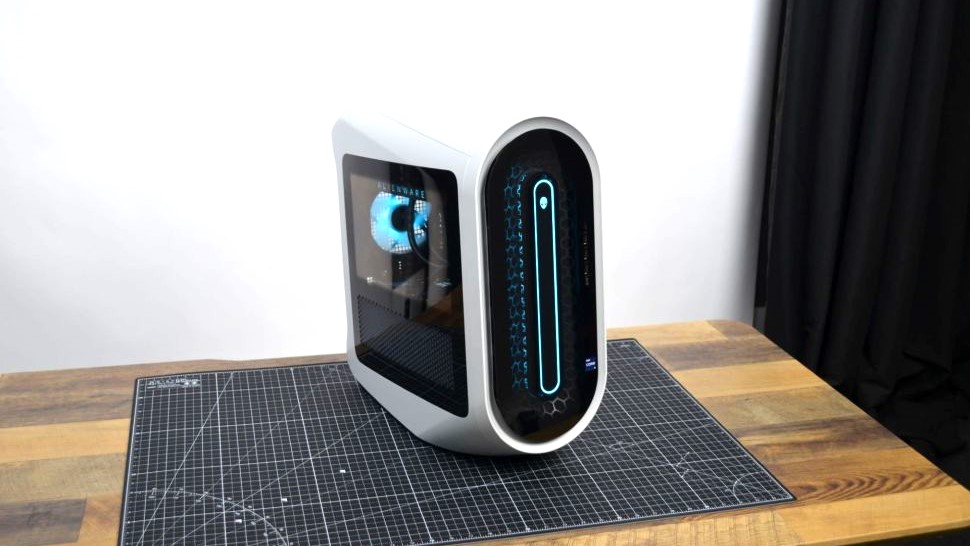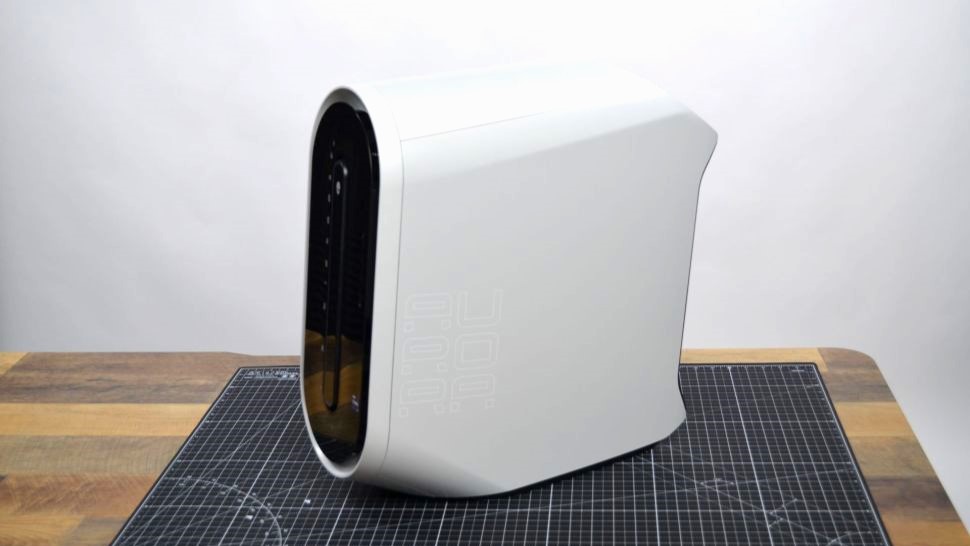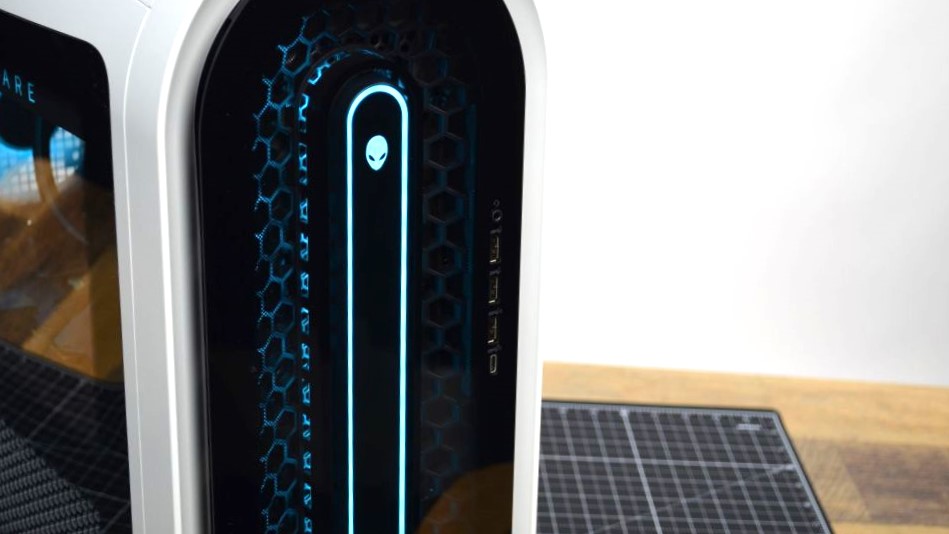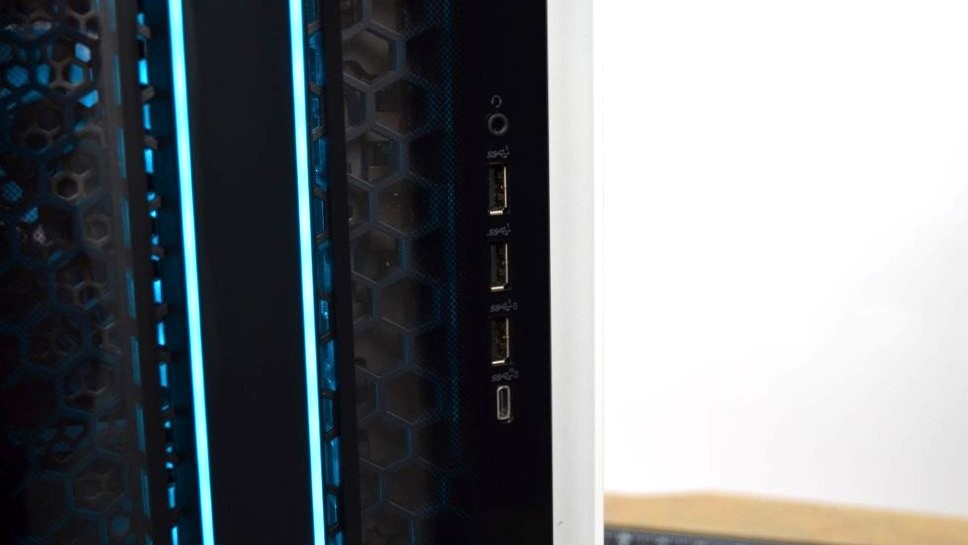Alienware Aurora R15: Two-minute review
The Alienware Aurora R15 is the latest refresh in the Aurora line of PCs, coming after the Alienware Aurora R13. The latter was a performance monster, so much so that the weak CPU cooler couldn’t keep up and caused massive overheating issues. Thankfully, that’s not the case with the R15.
Alienware is Dell’s premium brand of gaming PCs and laptops, and for good reason too. Not only do the gaming machines have some of the most unique and visually appealing designs and color palettes out there, but they’re also some of the best performing with the highest quality of specs out there.
The Alienware Aurora R15 is no exception to this golden rule, and it has received substantial upgrades. Notably, the cooling and ventilation system has had a massive overhaul. It now features 240mm liquid cooling that’s upgradable to 240mm Cryo-tech liquid cooling, five 120mm fans, a hexagonal side-venting for better airflow, and voltage regulator heatsinks on the motherboard for better cooling.
Long story short, I haven’t experienced a single issue with overheating or even just regular heating. The PC could be running Cyberpunk 2077 for three hours, and it wil still maintain an excellent internal temperature.
Its other specs are quite impressive — even the lowest priced one at $1,399.99 (around £1,175 / AU$2,085) has a respectable 13th-gen Intel Core i5 13400F, Nvidia GeForce RTX 3050, 8GB of DDR5 RAM, and 256GB of SSD. The one I received for review is the most powerful version, which is priced at a whopping $4,499.99 / £4,799.00 including VAT (around AU$6,700) and features a 13th-gen Intel Core i9-13900KF, Nvidia GeForce RTX 4090, 32GB of DDR5 RAM, and 1TB NVMe M.2 PCIe SSD (boot) along with 1TB 7200RPM SATA 6Gb/s (storage).
And while the pricing is outrageous, it matches the premium quality of both the absolutely stunning side glass chassis and the components themselves. The PC comes in two colors: Dark Side of the Moon and Lunar Light, which are both equally gorgeous and solely depends on your aesthetic preference.
Thanks to its specs, it is a bit on the heavy side, but it is surprisingly tame compared to other slightly larger PCs. It also has an impressive port selection that fits any possible need you may have for this PC. And thankfully the front batch of ports is not on the top of the PC, so less of a chance of getting dust in them.
Alienware Aurora R15: Price & availability

- Starting at $1,399.99 (around £1,175 / AU$2,085)
- Available now in the US and UK
Dell’s Alienware line has always been premium in both price and quality, and the Alienware Aurora R15 is no exception, as most configurations are quite expensive. However, Dell does offer one that, at the time of this writing, is a solid deal at $1,399.99 (around £1,175 / AU$2,085) – at least for those in the US. The UK only has the two most expensive configurations available, and Australia has none at all.
The unit I received for review is the most expensive model you can purchase, costing at the time of this writing $4,499.99 (£4,799.00 including VAT / around AU$6,700). This version comes with top-tier specs including a 13ᵗʰ Gen Intel Core i9-13900KF processor and an Nvidia GeForce RTX 4090 graphics card.
Alienware Aurora R15: Specs

The specs for the Alienware Aurora R15 review unit sent to me is as follows: 13th-gen Intel Core i9-13900KF processor, an Nvidia GeForce RTX 4090 24GB GDDR6X graphics card, 32GB of DDR5 RAM, and 1TB NVMe M.2 PCIe SSD storage. As you can tell, this is the highest possible configuration that you can get for this unit, and it chews up and spits out any PC game on the highest settings.
| Component | Base model | Review unit | Top configuration |
|---|---|---|---|
| Price | $1,399.99 / around £1,175 / AU$2,085) | $4,499.99 / £4,799 including VAT / around AU$6,700 | $5,559.99 / £5,799 including VAT / around AU$8,285 |
| CPU | 13th Gen Intel Core i5 13400F | 13ᵗʰ Gen Intel Core i9-13900KF | 13ᵗʰ Gen Intel Core i9-13900KF |
| GPU | Nvidia GeForce RTX 3050 | Nvidia GeForce RTX 4090 24GB GDDR6X | Nvidia GeForce RTX 4090 24GB GDDR6X |
| RAM | 8GB DDR5 | 32GB DDR5 | 64GB DDR5 |
| Storage | 256GB SSD | 1TB NVMe M.2 PCIe SSD | 4TB NVMe M.2 PCIe SS |
If you’re in the US, you can also purchase a much cheaper model with a solid configuration, though you’ll probably have to upgrade the RAM and storage space. This model comes with a 13th Gen Intel Core i5 13400F processor, an Nvidia GeForce RTX 3050 graphics card, 8GB of DDR5 RAM, and 256GB SSD storage.
There are also several other models in the US to choose from, with my personal favorite for those who want to have a powerful gaming machine without breaking the bank too much. This configuration comes with a 13th-gen Intel Core i7 13700F processor, an AMD Radeon RX 6700 XT graphics card (which is nearly comparable to the RTX 3070), 16GB of DDR5 RAM, and 512GB SSD storage, and it’ll set you back $2,249.99 (around £1,883 / AU$3,344).
Alienware Aurora R15: Design

- Striking design with a daring oval-shaped chassis
- Nice port selection
- Extensive cooling
One of the most prominent features of nearly any Alienware device is how striking and downright stunning each PC and laptop design is. The Alienware Aurora R15 continues this trend with a daring oval-shaped chassis complemented by both a glass side and one of two gorgeous color palettes to choose from.
The oval chassis not only creates a stark contrast to the more mainstream box look but also helps to shave off pounds from the overall unit. While it’s still a bit heavy, it’s more than possible for a single person to lift on their own, which I tested out by moving it around my apartment.

The overall port selection is quite excellent, with several USB Type-A and Type-C ports available for use in both the front and back. However, I do wish more Type-C ports were placed in the front, at least two of them versus only one since having to use the three in the back can be a bit annoying.
There are tons of other ports like a headset port, audio/microphone port, optical S/PDIF port, coaxial S/PDIF port, ethernet port, several HDMI ports, center/rear/side surround ports, an external antenna port, and line-in/out ports. There are also two slots for security: a Kensington security-cable slot and a padlock slot. There’s a port for pretty much any need you could possibly have.
A huge shoutout to the massively improved ventilation system on this PC. As I mentioned before, the previous R13 model has significant overheating issues due to the weak CPU heatsink. But this time around, Dell has gone above and beyond in its efforts to prevent this with 240mm liquid cooling that’s upgradable to 240mm Cryo-tech liquid cooling, five 120mm fans, a hexagonal side-venting for better airflow, and voltage regulator heatsinks on the motherboard for better cooling.
While it seems a little over the top, if you’re purchasing the model with an RTX 4090 graphics card, you need the extra cooling since a not-less-than-zero percentage of those cards like to catch on fire when overheated.
Alienware Aurora R15: Performance
- Performance beyond incredible
- Ventilation keeps PC cool at maxed-out settings
Alienware Aurora R15: Benchmarks
Here’s how the Alienware Aurora R15 performed in our suite of benchmark tests:
3DMark: Night Raid: 92,439; Fire Strike: 44,258; Time Spy: 30,392; Port Royal: 25,124
Cinebench R23 Multi-core: 35,033 points
GeekBench 5: 2,176 (single-core); 22,813 (multi-core)
PCMark 10 (Home Test): 9,609 points
Total War: Warhammer III (1080p, Ultra): 201 fps; (1080p, Low): 488 fps
Cyberpunk 2077 (1080p, Ultra): 154 fps; (1080p, Low): 155 fps
Dirt 5 (1080p, Ultra): 183 fps; (1080p, Low): 254 fps
The performance of the Alienware Aurora R15 is beyond incredible, blowing any gaming PC outfitted with previous-generation hardware out of the water with ease. I compared the R15 with another desktop PC I recently reviewed, the Acer Predator Orion 7000, to see how current-gen components would fair in benchmarks, and the differences in performance are like night and day.
Keep in mind that the Orion 7000 is no slouch, outfitted with a 12th-gen Intel Core i7 processor and an RTX 3080 graphics card. But for instance, when running the Cyberpunk 2077 benchmark on both PCs on Ultra settings, the Orion 7000 averaged at a great 63FRS while the R15 ran at 154FPS, nearly twice the framerates (this was without DLSS turned on). Comparing Dirt 5, the former averaged at 82FPS and the latter managed 183FPS, over 100 points difference.
Deciding to push things a little further, I tested out both Cyberpunk 2077 and Marvel’s Spider-Man Remastered, the latter of which is a technical marvel on PC, to some excellent results. I completely maxed out graphics settings on Cyberpunk and set the framerate requirement to about 240, then ran the benchmark with and without DLSS. The latter managed to stay at a consistent 27FPS, while the former immediately shot up to and stayed at an average of 59FPS.
Meanwhile, maxing out Spider-Man’s graphics with DLSS on and setting the framerate requirement to about 160FPS, I tested out web-swinging through the metropolis and combat on the hardest difficulty with tons of civilians and gun-wielding bad guys around. The former scenario saw the framerate stay above 100FPS, and in the latter, I never saw the framerate dip before 150FPS. It was staggering how incredible the graphics and performance were while running butter smooth all the while.
And the best part was that ventilation made for an experience that kept the PC running nice and cool. It seems that Dell took to heart the missteps of the R13 and created a cooling system that could fully support the power of its components.
Should you buy the Alienware Aurora R15?
| Attributes | Notes | Rating |
|---|---|---|
| Price | The price tag may be hefty but considering the specs it’s more than worth it. | 4.5 / 5 |
| Specs | There’s a wide range of configurations offered, with the priciest having the most premium specs. | 5 / 5 |
| Design | A gorgeous chassis coupled with excellent port selection and ventilation. | 5 / 5 |
| Performance | You can safely crank up the settings on any PC game and it will run phenomenally. | 5 / 5 |
Buy it if…
Don’t buy it if…
Alienware Aurora R15: Also consider
| Alienware Aurora R15 | Maingear Turbo | Corsair PC Build Kit | |
|---|---|---|---|
| Price: | $4,499.99 / £4,799 including VAT / around AU$6,700 | $5,807 / £4,865 / AU$8,645 | $1,199.99 / £1,005 / AU$1,786 |
| CPU | 13ᵗʰ Gen Intel Core i9-13900KF | AMD Ryzen 7 5800X3D | Intel Core i5-13400F |
| GPU | Nvidia GeForce RTX 4090 24GB GDDR6X | Nvidia GeForce RTX 3080 Ti | Nvidia GeForce RTX 3060 |
| RAM | 32GB DDR5 | Asus B660-PLUS 16GB DDR4 | 32GB DDR4 |
| Storage | 1TB NVMe M.2 PCIe SSD | 1 x 1TB M.2, 1 x 2TB SSD | 1TB PCIe 4.0 SSD |
If the Alienware Aurora R15 has you considering other options, here are two more gaming PCs to consider…
How I tested the Alienware Aurora R15
- I tested the Alienware Aurora R15 for about a week
- I tested PC games at both low and high settings
- I used a variety of benchmarks as well as general gameplay to test performance
First, I tested the general weight of the Alienware Aurora R15 by lifting it up and around my apartment. After I set it up, I ran several benchmarks to test out both the processor and graphics card, as well as in-game gameplay performance. Finally, I stress-tested out titles like Marvel’s Spider-Man Remastered and Cyberpunk 2077 in various settings to see both overall performance and ventilation quality.
The Alienware Aurora R15 is specially made as a gaming PC, which meant the brunt of my testing revolved around checking game performance and looking for any ventilation issues.
I’ve tested plenty of gaming PCs and laptops, making me more than qualified to understand benchmark test results and how to properly stress test machines to see how well they work during both casual and intense gaming sessions.
First reviewed March 2023





